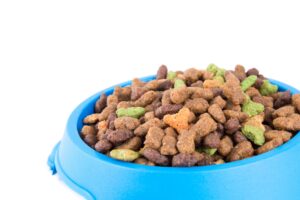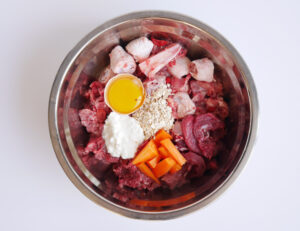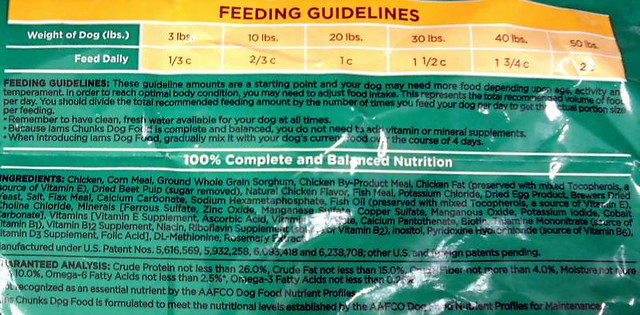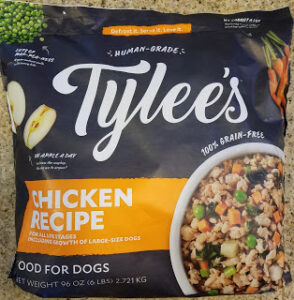
Written By Dr. Amy Clark
I want to share a compassionate credible recommendation with you about Pet Nutrition.

Our domestic dogs are not wolves, and should not be fed as such. You do not have to respect the dog’s carnivorous nature when it comes to diet. That is a marketing myth.
I can divide diet type into two different categories:
Ancestral “evolutionary” based diet mimics the natural diet of dog’s wild ancestors (wolves) and is varied based upon what is regionally/seasonally available.
“Evidence” based diet accounts for scientific knowledge that is optimal to prevent or treat disease.

What is the goal of these animals?
A wild animal’s primary goal is survival and reproduction.
The primary goal for our pets is longevity and quality of life.
Very different goals lead to very different nutritional care.
Dogs became domesticated when they began living on the outskirts of society, scavenging our foods which are higher in starch (carbohydrates) than an ancestral diet. Their genetics changed in many ways, but in regards to digestion, became adapted to higher starch diets and diversified in breed variation.
Another concept in regards to cats. Whole prey diets in cats may meet protein and essential FFA, but can be deficient in mineral requirements and taurine which overtime will affect a cat’s health.

What is the best pet food?
Most importantly, you and your veterinarian want to be actively engaged in the well-being and health of your pets.
I recommend consulting with your veterinarian, as a knowledgeable resource on Nutrition.
ACVN.org Diplomate of American College of Veterinary Nutrition consult.
Choosing the appropriately balanced lifestage diet can be very confusing.
The most important aspect of any diet is one that has nutritional adequacy, hence has no deficiency.
Raw meat diets are typically high fat diets that claim shinier coat /skin, muscle mass gain, cleaner teeth, vitality/increased performance.

Raw meat diets have a high possibility for bacterial contamination (like Listeria, Salmonella, pathogenic Ecoli) which should be avoided with immune compromised owners/pets.
Plant based (Vegan)- note that calories come from protein, fats, carbohydrates. Raw materials screened for safety like corn as a “high risk ingredient” can develop Aflatoxin fungus.
Home prepared/Fresh cooked diet
You may have concerns regarding commercial pet food (recalls or processing), you may want to avoid additives and preservatives, have control of ingredients.
Requires a dedicated, active role to ensure nutritional adequacy. Published recipes can be deficient compared to AAFCO or NRC recommended allowances. Avoid using “a generic vitamin/mineral supplement” recommendation, avoid human supplements that can cause toxicity (ie Vit D, bioavailability for copper utilization).
Impact of processing: maillard reactions influence taste, smell, color and are associated with oxidative stress, vasoconstriction and inflammation and disease states like Diabetes mellitus, Osteoarthritis and Cognitive dysfunction syndrome.
Remember that pet food is marketing to us as the consumer, not our pets.
Ingredient lists and labels are a poor means to judge pet food.

Listed in descending order by weight, wet ingredients (like meat) contribute more water, less nutrients; dry contributes less water, more nutrients.
High moisture content- less nutrients like protein, essential FFA
Will not address differences in sourcing, variation in raw material quality, digestibility, bioavailability.
Digestibility is the amount of nutrients absorbed after consumption.
High digestibility >85% digestible with protein, fat, carbohydrates
Adding fiber to a diet will decrease digestibility.
Bioavailability is the proportion of a nutrient that is absorbed from the diet and used for normal body function, like minerals and vitamins.
Salt is usually not more than 1% of the food… every ingredient below on the label is a filler <1% with minimal contribution to nutrition.
Will use ingredients that have the same weight, can rank a meat product first even if the fiber source has the same weight.
Will fractionate to make the list more robust.

Labels such as “Organic”, “Natural”, “Human Grade”, “Grain Free” are marketing myths and have nothing to do with nutritional adequacy.
A vitamin like taurine is synthetic, not naturally derived.
“Natural” preservatives like mixed tocopherols (Vitamin E) is an extensively processed by- product of vegetable oil.
Regulatory claims only for consumer appeal.
“Grain-free” is believed to be free of “fillers”, which implies that grains are bad without a basis in fact. The diet is substituted with starches, legumes and potato. Antidotal health claims- reduces food allergic risk, improves gastrointestinal health, improves skin health, improves energy.
A misconception is that a “filler” provides empty calories with no nutritional value. For example rice provides fiber, essential FFA, minerals that does have nutritional value.
Finally,
Beware of rating websites.
For more information on the nutritional recommendations of Tender Care Veterinary Center please visit our Nutritional Counseling Page
Recommended web sources:
WSAVA Nutrition Toolkit (https://www.wsava.org)Recommendation on selecting pet foods
Independent certification of quality control (Global Food Safety Initiative, American Feed Industry Association)
http://petnutritionalliance.org
http://talkspetfood.aafco.org/
